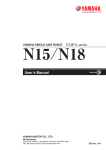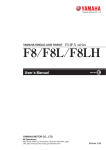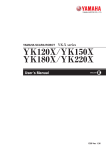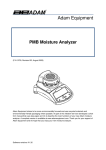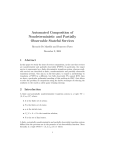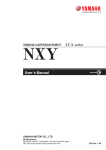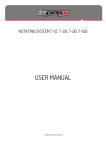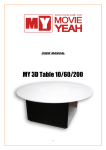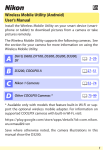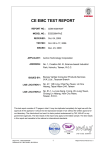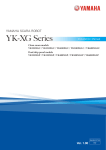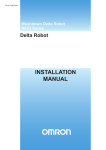Download N15/N18 User`s Manual
Transcript
YAMAHA SINGLE-AXIS ROBOT FLIP-X series N15/N18 User’s Manual ENGLISH E YAMAHA MOTOR CO., LTD. IM Operations 882 Soude, Naka-ku, Hamamatsu, Shizuoka 435-0054.Japan URL http://www.yamaha-motor.jp/robot/index.html E38-Ver. 1.05 Thank you for purchasing this YAMAHA single-axis robot N15/N18. Before using this robot, read the following notes and set the origin position. The N15/N18 single-axis robots use absolute position detectors that do not require returnto-origin after turning on the controller power. However, when the controller power is turned on in the following cases, return-to-origin must be performed just the very first time. (1) When robot cable was first connected after delivery from YAMAHA. (2) When robot cable was disconnected from the controller and then reconnected. (3) When no absolute battery is connected. (4) When a motor or cable was replaced. At this point, any of the following errors is issued immediately after controller power is turned on, but this is not a malfunction. The controller will operate normally by restarting. When using an SR1 controller: 15 : FEEDBACK ERROR 2 23 : ABS.BAT.L-VOLTAGE 24 : ABS.DATA.ERROR … etc. When using an RCX240, RCX222 controller: 17.81 : D?.ABS.battery wire breakage 17.92 : D?.Resolver disconnected during power off 17.93 : D?.Position backup counter overflow … etc. When using an TS-X controller: 82 ENCODER ERROR 83 ABS. ENCODER ERR. 8A ABS. BATTERY ERR. 8B ABS. COUNT ERROR 8D ABS. OVERFLOW ERR. … etc. Before using the N15/N18 single-axis robots (Be sure to read the following notes.) Before using the N15/N18 single-axis robots (Be sure to read the following notes.) Setting the origin position Before using the N15/N18 single-axis robots (Be sure to read the following notes.) Set the origin position by referring to the following section in the robot controller user's manual. When using an SR1 controller: See "9.1.1 Return-to-origin by the search method" in Chapter 9 of the "HPB Operation Guide" section. When using an RCX240 controller: See "11.9 Absolute reset" in Chapter 4. When using an RCX222 controller: See "11.8 Absolute reset" in Chapter 4. When using an TS-X controller: See "6.2 Origin search (return-to-origin)" in "6. Operating the robot" of the "HT1 Operation Guide" section. c CAUTION Changing the origin position to the opposite side of the initial position may cause a position shift or robot breakdowns, so use caution. Avoid changing the origin detection method since it is dangerous in some cases. If the origin position must be changed, please consult our sales office or dealer. After setting the origin position, affix the stickers (triangular stickers supplied with the robot) to both the tool side and workpiece side so that they can be used as the alignment marks. Use these marks as the reference position the next time the origin position must be set. General Contents General Contents Introduction Chapter 1 Using the Robot Safely 1-1 Safety information 1-1 1-2 Essential precautions 1-3 1-3 Industrial robot operating and maintenance personnel 1-9 1-4 Robot safety functions 1-10 1-5 Safety measures for the system 1-11 1-6 Trial operation 1-11 1-7 Work within the safety enclosure 1-12 1-8 Automatic operation 1-13 1-9 Warranty 1-14 Chapter 2 Product Overview 2-1 Checking the product 2-1 2-2 Robot part names 2-2 2-3 Robot internal structure 2-3 Chapter 3 Installation and connections 3-1 Carrying the robot 3-1 3-2 Robot Installation Conditions 3-2 3-2-1 3-2-2 Installation environments Installation base 3-3 Installing the robot 3-5 3-4 Connecting the robot to the controller 3-9 3-5 Precautions during user wiring and hose installation 3-12 3-2 3-3 i Chapter 4 Periodic inspection and maintenance General Contents 4-1 Before beginning work 4-1 4-2 Periodic inspection 4-3 4-2-1 4-2-2 4-2-3 4-2-4 Daily inspection Three-month inspection Six-month inspection Three-year inspection 4-3 4-3 4-4 4-4 4-3 Applying grease 4-5 4-4 Replacing the motor 4-7 Chapter 5 Troubleshooting 5-1 If you suspect trouble 5-1-1 5-1-2 Positioning error Feedback error 5-1 5-1 5-2 Chapter 6 Specifications 6-1 Main unit specifications 6-1 6-1-1 6-1-2 N15/N15D N18/N18D 6-1 6-11 6-2 Robot connector (I/O signal connector) 6-21 6-3 Robot connector (motor connector) 6-21 Appendix ii About machine reference i Moment of inertia calculation ii Introduction • This user's manual should be used with the robot and considered an integral part of it. When the robot is moved, transferred or sold, send this manual to the new user along with the robot. Be sure to explain to the new user the need to read through this manual. • Specifications of robot models other than standard models may be omitted in this manual if they are common to those of standard models. In this case, refer to the specifications of standard models. • For details on specific operation of the robot, refer to the separate user’s manual for the robot controller being used. NOTES ◆ The contents of this manual are subject to change without prior notice. ◆ While every effort has been made to ensure the contents of this manual are correct, please contact us if you find any part of this manual to be unclear, confusing or inaccurate. YAMAHA MOTOR CO., LTD. IM Operations Introduction The YAMAHA single-axis robots N15/N18 is an industrial robot that uses the absolute positioning method as standard and has improved ease of use, resistance to environmental conditions, and maintenance work. A wide varaiety of product lineup allows you to select the desired robot model that best matches your application. This user's manual describes the safety measures, handling, adjustment and maintenance of the N15/N18 robots for correct, safe and effective use. Be sure to read this manual carefully before installing the N15/N18 robots. Even after you have read this manual, keep it in a safe and convenient place for future reference. MEMO Chapter 1 Using the Robot Safely Contents 1-1 Safety information 1-1 1-2 Essential precautions 1-3 1-3 Industrial robot operating and maintenance personnel 1-9 1-4 Robot safety functions 1-10 1-5 Safety measures for the system 1-11 1-6 Trial operation 1-11 1-7 Work within the safety enclosure 1-12 1-8 Automatic operation 1-13 1-9 Warranty 1-14 1-1 Safety information 1-1 Safety information Warning symbols and signal words used in this manual are classified as explained below. Make sure that you fully understand the meaning of each symbol and comply with the instructions. w w c n DANGER FAILURE TO FOLLOW DANGER INSTRUCTIONS WILL RESULT IN SEVERE INJURY OR DEATH TO THE ROBOT OPERATOR, BYSTANDERS OR PERSONS INSPECTING OR REPAIRING THE ROBOT. WARNING FAILURE TO FOLLOW WARNING INSTRUCTIONS COULD RESULT IN SEVERE INJURY OR DEATH TO THE ROBOT OPERATOR, BYSTANDERS OR PERSONS INSPECTING OR REPAIRING THE ROBOT. CAUTION Failure to follow CAUTION instructions may result in injury to the robot operator, bystanders or persons inspecting or repairing the robot, or damage to the robot and/or robot controller. NOTE Explains the key point in the operation in a simple and clear manner. Reference Gives useful information related to the robot operation. 1-1 1 Using the Robot Safely Industrial robots are highly programmable, mechanical devices that provide a large degree of freedom when performing various manipulative tasks. To ensure correct and safe use of YAMAHA industrial robots, carefully read this manual and make yourself well acquainted with the contents. FOLLOW THE WARNINGS, CAUTIONS AND INSTRUCTIONS included in this manual. Failure to take necessary safety measures or mishandling due to not following the instructions in this manual may result in trouble or damage to the robot and injury to personnel (robot operator or service personnel) including fatal accidents. 1-1 Safety information Refer to the user's manual by any of the following methods to operate or adjust the robot safely and correctly. 1 1. Operate or adjust the robot while referring to the printed version of the user's manual (available for an additional fee). Using the Robot Safely 2. Operate or adjust the robot while viewing the CD-ROM version of the user's manual on your computer screen. 3. Operate or adjust the robot while referring to a printout of the necessary pages from the CD-ROM version of the user's manual. It is not possible to list all safety items in detail within the limited space of this manual. So it is essential that the user have a full knowledge of basic safety rules and also that the operator makes correct judgments on safety procedures during operation. For specific safety information and standards, refer to the applicable local regulations and comply with the instructions. This manual and warning labels supplied with or attached to the robot are written in English. Unless the robot operators or service personnel understand English, do not permit them to handle the robot. * Cautions regarding the official language of EU countries For equipment that will be installed in EU countries, the language used for the user's manuals, CE declarations, and operation screen characters is English only. Warning labels only have pictograms or else include warning messages in English. In the latter case, Japanese messages might be added. 1-2 1-2 Essential precautions 1-2 Essential precautions (1) Obser ve the following cautions during automatic operation. • Install a safeguard (safety enclosure) to keep any person from entering within the movement range of the robot and suffering injury due to being struck by moving parts. • Install a safety interlock that triggers emergency stop when the door or panel is opened. • Install a safety enclosure so that no one can enter inside except from doors or panels equipped with safety interlocks. • Warning labels 1 are supplied with the robot and should be affixed to conspicuous spots on doors or panels equipped with safety interlocks. w DANGER SERIOUS INJURY OR DEATH WILL RESULT FROM IMPACT WITH MOVING ROBOT. • KEEP OUTSIDE OF GUARD DURING OPERATION. • LOCK OUT POWER BEFORE APPROACHING ROBOT. Warning label 1 DANGER Serious injury or death will result from impact with moving robot. • Keep outside of guard during operation. • Lock out power before approaching robot. (2) Use caution to prevent hands or fingers from being pinched or crushed. Warning label 2 is affixed to the robot. Use caution to prevent hands or fingers from being pinched or crushed by the moving parts when carrying the robot or during teaching. w WARNING MOVING PARTS CAN PINCH OR CRUSH. KEEP HANDS AWAY FROM ROBOT ARMS. 1-3 1 Using the Robot Safely Particularly important cautions for handling or operating the robot are described below. In addition, precautions during installation, operation, inspection and maintenance are also provided in each chapter. Be sure to comply with these instructions to ensure safe use of the robot. 1-2 Essential precautions Warning label 2 1 WARNING Using the Robot Safely Moving parts can pinch or crush. Keep hands away from robot arms. (3) Follow the instructions on warning labels and in this manual. • Be sure to read the warning labels and this manual carefully and make sure you thoroughly understand their contents before attempting installation and operation of the robot. • Before starting robot operation, be sure to reread the procedures and cautions relating to your work as well as descriptions in this chapter (Chapter 1, "Using the Robot Safely"). • Never install, adjust, inspect or service the robot in any manner that does not comply with the instructions in this manual. • The warning labels 3 are supplied with the robot and should be affixed to the robot or conspicuous spots near the robot. w WARNING IMPROPER INSTALLATION OR OPERATION CAN RESULT IN SERIOUS INJURY OR DEATH. READ THE USER'S MANUAL AND ALL WARNING LABELS BEFORE OPERATION. Warning label 3 WARNING Improper installation or operation can result in serious injury or death. Read user's(owner’s) manual and all warning labels before operation. 1-4 1-2 Essential precautions (4) Do not remove, alter or stain the warning labels. w Do not use the robot in environments containing inflammable gas, etc. w (6) WARNING • THIS ROBOT WAS NOT DESIGNED FOR OPERATION IN ENVIRONMENTS WHERE INFLAMMABLE OR EXPLOSIVE SUBSTANCES ARE PRESENT. • DO NOT USE THE ROBOT IN ENVIRONMENTS CONTAINING INFLAMMABLE GAS, DUST OR LIQUIDS. EXPLOSIONS OR FIRE MIGHT OTHERWISE RESULT. Do not use the robot in locations possibly subject to electromagnetic interference, etc. w (7) 1 WARNING AVOID USING THE ROBOT IN LOCATIONS SUBJECT TO ELECTROMAGNETIC INTERFERENCE, ELECTROSTATIC DISCHARGE OR RADIO FREQUENCY INTERFERENCE. MALFUNCTIONS MIGHT OTHERWISE OCCUR. Provide safety measures for end effector (gripper, etc.). w WARNING • END EFFECTORS MUST BE DESIGNED AND MANUFACTURED SO THAT THEY CREATE NO HAZARDS (FOR EXAMPLE, A WORKPIECE THAT COMES LOOSE) EVEN IF POWER (ELECTRICITY, AIR PRESSURE, ETC.) IS SHUT OFF OR POWER FLUCTUATIONS OCCUR. • IF THERE IS A POSSIBLE DANGER THAT THE OBJECT GRIPPED BY THE END EFFECTOR MAY FLY OFF OR DROP, THEN PROVIDE APPROPRIATE SAFETY PROTECTION TAKING INTO ACCOUNT THE OBJECT SIZE, WEIGHT, TEMPERATURE AND CHEMICAL PROPERTIES. 1-5 Using the Robot Safely (5) WARNING IF WARNING LABELS ARE REMOVED OR DIFFICULT TO SEE, THEN ESSENTIAL PRECAUTIONS MIGHT NOT BE TAKEN, RESULTING IN ACCIDENTS. • DO NOT REMOVE, ALTER OR STAIN THE WARNING LABELS ON THE ROBOT. • DO NOT ALLOW THE WARNING LABELS TO BE HIDDEN BY DEVICES INSTALLED ONTO THE ROBOT BY THE USER. • PROVIDE PROPER LIGHTING SO THAT THE SYMBOLS AND INSTRUCTIONS ON THE WARNING LABELS CAN BE CLEARLY SEEN EVEN FROM OUTSIDE THE SAFETY ENCLOSURE. 1-2 Essential precautions (8) Use caution when removing the motor. (Vertical use robots) w 1 Using the Robot Safely (9) WARNING THE VERTICAL AXIS WILL SLIDE DOWN WHEN THE MOTOR IS RELEASED, CAUSING A HAZARDOUS SITUATION. • TURN OFF THE ROBOT CONTROLLER AND PROP UP THE VERTICAL AXIS WITH A SUPPORT STAND BEFORE REMOVING THE MOTOR. • BE CAREFUL NOT TO LET YOUR BODY GET CAUGHT BETWEEN THE VERTICAL AXIS PARTS AND INSTALLATION BASE. Be careful not to touch the motor and peripheral parts when hot. w WARNING The motor and speed reduction gear casing are extremely hot after automatic operation, so burns may occur if these are touched. Before handling these parts during inspection or servicing, turn off the controller, wait for a while and check that the parts have cooled. (10) Take the following safety precautions during inspection of controller. w WARNING • WHEN YOU NEED TO TOUCH THE TERMINALS OR CONNECTORS ON THE OUTSIDE OF THE CONTROLLER DURING INSPECTION, ALWAYS FIRST TURN OFF THE CONTROLLER POWER SWITCH AND ALSO THE POWER SOURCE IN ORDER TO PREVENT POSSIBLE ELECTRICAL SHOCK. • NEVER TOUCH ANY INTERNAL PARTS OF THE CONTROLLER. • REFER TO THE "YAMAHA ROBOT CONTROLLER USER'S MANUAL" FOR PRECAUTIONS ON HANDLING THE CONTROLLER. (11) Use caution not to touch the controller cooling fan. w 1-6 WARNING • BODILY INJURY MAY OCCUR FROM COMING INTO CONTACT WITH THE COOLING FAN WHILE IT IS ROTATING. • WHEN REMOVING THE FAN COVER FOR INSPECTION, FIRST TURN OFF THE CONTROLLER AND MAKE SURE THE FAN HAS STOPPED. 1-2 Essential precautions (12) Consult us for corrective action when the robot is damaged or malfunctions occur. w WARNING IF ANY PART OF THE ROBOT IS DAMAGED OR ANY MALFUNCTION OCCURS, CONTINUING THE OPERATION MAY BE VERY DANGEROUS. PLEASE CONSULT YOUR YAMAHA SALES OFFICE OR DEALER FOR CORRECTIVE ACTION. Using the Robot Safely Damage or Trouble 1 Possible Danger Damage to machine harness or robot cable Electrical shock, malfunction of robot Damage to exterior of robot Flying outwards of damaged parts during robot operation Abnormal operation of robot (positioning error, excessive vibration, etc.) Malfunction of robot (13) Protective bonding w WARNING BE SURE TO GROUND THE ROBOT AND CONTROLLER TO PREVENT ELECTRICAL SHOCK. (14) Be sure to make correct parameter settings. c CAUTION The robot must be operated with correct tolerable moment of inertia and acceleration coefficients according to the manipulator tip mass and moment of inertia. If these are not correct, drive unit service life may end prematurely, and damage to robot parts or residual vibration during positioning may result. (15) Follow the specified procedures when installing, adjusting or inspecting the robot. w WARNING ALWAYS FOLLOW THE SPECIFIED PROCEDURES WHEN INSTALLING, ADJUSTING OR INSPECTING THE ROBOT. NEVER ATTEMPT ANY PROCEDURE NOT DESCRIBED IN THIS MANUAL. (16) Do not attempt any repair, parts replacement and modification. w WARNING DO NOT ATTEMPT ANY REPAIR, PARTS REPLACEMENT AND MODIFICATION UNLESS DESCRIBED IN THIS MANUAL. THESE WORKS REQUIRE TECHNICAL KNOWLEDGE AND SKILL, AND MAY ALSO INVOLVE WORK HAZARDS. 1-7 1-2 Essential precautions (17) Location for installing the controller and the programming box or Handy Terminal The robot controller, programming box, and Handy Terminal should be installed at a location that is outside the robot movement range yet where it is easy to operate and view the robot performing tasks. 1 Using the Robot Safely (18) Protect electrical wiring and hydraulic/pneumatic hoses as needed. Install a cover or similar item to protect the electrical wring and hydraulic/pneumatic hoses from possible damage. (19) Install an operation status light. Install an operation status light (signal light tower, etc.) at an easy-to-see position so the operator will know whether the robot is merely stopped or is in emergency-error stop. (20) Clean work tools, etc. Work tools such as welding guns and paint nozzles which are mounted in the robot arm will preferably be cleaned automatically. (21) Provide adequate lighting. Make sure to provide enough lighting to ensure safety during work. (22) Prevent the gripped object from flying outwards. If the object or workpiece gripped by the robot might fly outward or drop and create a hazard to the operator, then protective equipment should be installed by taking the size, weight, temperature and chemical properties of the object into account. (23) Draw up "work instructions" and makes sure the operator learns them well. Decide on "work instructions" for the following items in cases where personnel must work within the robot movement range to perform teaching, maintenance or inspection. Make sure the workers know these "work instructions" well. (1) Robot operating procedures needed for tasks such as startup procedures and handling switches (2) Robot speeds used during tasks such as teaching (3) Methods for workers to signal each other when two or more workers perform tasks (4) Steps that the worker should take when a problem or emergency occurs (5) Steps to take after the robot has come to a stop when the emergency stop device was triggered, including checks for cancelling the problem or error state and safety checks in order to restart the robot. (6) In cases other than above, the following actions should be taken as needed to prevent hazardous situations due to sudden or unexpected robot operation or faulty robot operation, as listed below. 1. Show a display on the operator panel 1-8 1-3 Industrial robot operating and maintenance personnel 2. Ensure the safety of workers performing tasks within the robot movement range 3. Clearly specify position and posture during work Position and posture where worker can constantly check robot movements and immediately move to avoid trouble if an error/problem occurs 5. Use methods for signaling operators of related equipment 6. Use methods to decide that an error has occurred and identify the type of error Implement the "work instructions" according to the type of robot, installation location, and type of work task. When drawing up the "work instructions", make an effort to include opinions from the workers involved, equipment manufacture's technicians, and workplace safety consultants, etc. (24) Display a sign on operation panel during work Display an easy to understand sign or message on the programming box, Handy Terminal, and operation panel during the job task, to prevent anyone other than the operators for that job task from mistakenly operating a start or selector switch. If needed, take other measures such as locking the cover on the operation panel. (25) Make daily and periodic inspections. (1) Always make sure that daily and periodic inspections are performed, and make a pre-work check to ensure there are no problems with the robot or related equipment. If a problem or abnormality is found, then promptly repair it or take other measures as necessary. (2) When you make periodic inspections or repairs, make a record and store it for at least 3 years. 1-3 Industrial robot operating and maintenance personnel Operators or persons who handle the robot such as for teaching, programming, movement check, inspection, adjustment, and repair must receive appropriate training and also have the skills needed to perform the job correctly and safely. They must read the user's manual carefully to understand its contents before attempting the robot operation. Tasks related to industrial robots (teaching, programming, movement check, inspection, adjustment, repair, etc.) must be performed by qualified persons who meet requirements established by local regulations and safety standards for industrial robots. 1-9 Using the Robot Safely 4. Install noise prevention measures 1 1-4 Robot safety functions 1-4 1 (1) Robot safety functions Overload detection This function detects an overload applied to the motor and shuts off the servo power. Using the Robot Safely (2) Overheat detection This detects an abnormal temperature rise in the controller driver and shuts off the servo power. If an overload or overheat error occurs, take the following measures. 1. Insert a timer in the program. 2. Reduce the acceleration coefficient. (3) Soft limits Soft limits can be set on each axis to limit the working envelope in manual operation after return-to-origin and during automatic operation. Note: The working envelope is the area limited by soft limits. w (4) WARNING SOFT LIMITS MUST BE SET WITHIN THE MOVEMENT RANGE (MECHANICAL STOPPER). IF THE SOFT LIMIT IS SET OUTSIDE THE MOVEMENT RANGE, THE ROBOT AXIS MAY COLLIDE WITH THE MECHANICAL STOPPER AT HIGH SPEED, CAUSING THE OBJECT GRIPPED BY THE END EFFECTOR TO FLY OR DROP AND THE ROBOT TO MALFUNCTION. Mechanical stoppers If the servo power is suddenly shut off during high-speed operation by emergency stop or safety functions, these mechanical stoppers prevent the axis from exceeding the movement range. Note: The movement range is the area limited by mechanical stoppers. w 1-10 WARNING ROBOT MOVEMENT WILL NOT STOP IMMEDIATELY AFTER THE SERVO POWER SUPPLY IS SHUT OFF BY EMERGENCY STOP OR OTHER SAFETY FUNCTIONS. 1-5 Safety measures for the system 1-5 Safety measures for the system 1-6 Trial operation After making installations, adjustments, inspections, or maintenance or repairs to the robot, make a trial run using the following procedures. (1) If a safety enclosure has not yet been provided right after installation of the robot, rope off or chain off around the movement area of the manipulator in place of the safety enclosure, and obser ve the following points. 1. Use sturdy, stable posts which will not fall over easily. 2. The rope or chain should be easily visible by everyone around the robot. 3. Place a sign to keep the operator or other personnel from entering the movement range of the manipulator. (2) Check the following points before turning on the controller. 1. Is the robot securely and correctly installed? 2. Are the electrical connections to the robot correct? 3. Are items such as air pressure correctly supplied? 4. Is the robot correctly connected to peripheral equipment? 5. Have safety measures (safety enclosure, etc.) been taken? 6. Does the installation environment meet the specified standards. (3) After the controller is turned on, check the following points from outside the safety enclosure. 1. Does the robot start and stop as intended? Can the operation mode be selected correctly? 2. Does each axis move as intended within the soft limits? 3. Does the end effector move as intended? 4. Are the signal transmissions to the end effector and peripheral equipment correct? 5. Does emergency stop work? 6. Are the teaching and playback functions normal? 7. Are the safety enclosure and interlock working as intended? 8. Does the robot move correctly during automatic operation? 1-11 1 Using the Robot Safely Since the robot is commonly used in conjunction with an automated system, dangerous situations are more likely to occur from the automated system than from the robot itself. Accordingly, appropriate safety measures must be taken on the part of the system manufacturer according to the individual system. The system manufacturer should provide a proper instruction manual for safe, correct operation and servicing of the system. 1-7 Work within the safeguard enclosure 1-7 1 Work within the safety enclosure (1) Work within the safety enclosure Using the Robot Safely When work is required inside the safety enclosure, always turn off the controller and place a sign indicating that the robot is being adjusted or serviced in order to keep any other person from touching the controller switch or operation panel, except for the following cases. 1) Soft limit settings 2) Teaching For item 1), follow the precautions and procedure for each section. To perform item 2), refer to the description in (2) below. (2) Teaching When performing teaching within the safety enclosure, comply with the instructions listed below. 1) Check or perform the following points from outside the safety enclosure. 1. Make sure that no hazards are present within the safety enclosure by a visual check. 2. Check that the programming unit HPB (option) operates correctly. 3. Check that no failures are found in the robot. 4. Check that emergency stop works correctly. 5. Select teaching mode and prohibit automatic operation. 2) Never enter the movement range of the manipulator while within the safety enclosure. 1-12 1-8 Automatic operation 1-8 Automatic operation 1 Automatic operation described here includes all operations in AUTO mode. (1) Check the following before starting automatic operation. 2. The programming unit and tools are in their specified locations. 3. The alarm or error lamps on the robot and peripheral equipment do not flash. 4. The safety enclosure is securely installed with safety interlocks actuated. (2) Obser ve the following during automatic operation or in cases where an error occurs. 1)After automatic operation has started, check the operation status and signal light to ensure that the robot is in automatic operation. 2) Never enter the safety enclosure during automatic operation. 3) If an error occurs in the robot or peripheral equipment, observe the following procedure before entering the safety enclosure. 1. Press the emergency stop button to set the robot to emergency stop. 2. Place a sign on the start switch, indicating that the robot is being inspected in order to keep any other person from touching the start switch and restarting the robot. 1-13 Using the Robot Safely 1. No one is within the safety enclosure. 1-9 Warranty 1-9 1 Warranty The YAMAHA robot and/or related product you have purchased are warranted against the defects or malfunctions as described below. Using the Robot Safely Warranty description : If a failure or breakdown occurs due to defects in materials or workmanship in the genuine parts constituting this YAMAHA robot and/or related product within the warranty period, then YAMAHA will repair or replace those parts free of charge (hereafter called "warranty repair"). Warranty Period : The warranty period ends when any of the following applies: (1) After 18 months (one and a half year) have elapsed from the date of shipment (2) After one year has elapsed from the date of installation (3) After 2,400 hours of operation Exceptions to the Warranty : This warranty will not apply in the following cases: (1) Fatigue arising due to the passage of time, natural wear and tear occurring during operation (natural fading of painted or plated surfaces, deterioration of parts subject to wear, etc.) (2) Minor natural phenomena that do not affect the capabilities of the robot and/or related product (noise from computers, motors, etc.). (3) Programs, point data and other internal data that were changed or created by the user. Failures resulting from the following causes are not covered by warranty repair. 1) Damage due to earthquakes, storms, floods, thunderbolt, fire or any other natural or man-made disasters. 2) Troubles caused by procedures prohibited in this manual. 3) Modifications to the robot and/or related product not approved by YAMAHA or YAMAHA sales representatives. 4) Use of any other than genuine parts and specified grease and lubricants. 5) Incorrect or inadequate maintenance and inspection. 6) Repairs by other than authorized dealers. 1-14 1-9 Warranty 1-15 1 Using the Robot Safely YAMAHA MOTOR CO., LTD. MAKES NO OTHER EXPRESS OR IMPLIED WARRANTIES, INCLUDING ANY IMPLIED WARRANTY OF MERCHANTABILITY OR FITNESS FOR ANY PARTICULAR PURPOSE. THE WARRANTY SET FORTH ABOVE IS EXCLUSIVE AND IS IN LIEU OF ALL EXPRESSED OR IMPLIED WARRANTIES, INCLUDING WARRANTIES OF MERCHANTABILITY, FITNESS FOR A PARTICULAR PURPOSE, OR WARRANTIES ARISING FROM A COURSE OF DEALING OR USAGE OF TRADE. YAMAHA MOTOR CO., LTD. SOLE LIABILITY SHALL BE FOR THE DELIVERY OF THE EQUIPMENT AND YAMAHA MOTOR CO., LTD. SHALL NOT BE LIABLE FOR ANY CONSEQUENTIAL DAMAGES (WHETHER ARISING FROM CONTRACT, WARRANTY, NEGLIGENCE OR STRICT LIABILITY). YAMAHA MOTOR CO., LTD. MAKES NO WARRANTY WHATSOEVER WITH REGARD TO ACCESSORIES OR PARTS NOT SUPPLIED BY YAMAHA MOTOR CO., LTD. MEMO 1-16 Chapter 2 Product Over view Contents 2-1 Checking the product 2-1 2-2 Robot part names 2-2 2-3 Robot internal structure 2-3 2-1 Checking the product 2-1 Checking the product After unpacking, make sure that all components and accessories are included (as specified in your order). Also check the product for any damage on the exterior which might have occurred during shipping. If there are any missing parts or damage due to shipping, please notify your YAMAHA sales office or representative immediately. Product Overview w 2 WARNING • ALWAYS USE TWO OR MORE PEOPLE TO TAKE THE ROBOT UNIT OUT OF THE PACKAGE. EACH PERSON SHOULD GRIP THE ROBOT UNIT NEAR ONE END FROM THE LOWER SIDE. CARRY WITH THE ROBOT FACING UPWARD (SLIDER SIDE UPWARDS). • WHEN UNPACKING, CAREFULLY HOLD THE ROBOT NOT TO DROP IT. IF THE ROBOT FALLS, SERIOUS INJURY MAY OCCUR OR THE ROBOT MAY BE DAMAGED. 2-1 2-2 Robot part names 2-2 Robot part names Robot part names External components 2 Robot cable (motor wires) Product Overview Robot cable (I/O signal wires) Cable cover Slider Cable carrier End cover 1 End cover 2 Reference The direction of the cables coming out of the cable carrier depends on the specifications you ordered. The above illustration shows an example of RH (right and horizontal) type. 2-2 2-3 Robot internal structure 2-3 Robot internal structure The YAMAHA N15/N18 single-axis robots are truly innovative single-axis robot using a hollow motor as its drive source. The internal robot structure and features are described here. 2 <N15> Product Overview Slider Linear guide Hollow motor 2-3 MEMO 2-4 Chapter 3 Installation and connections Contents 3-1 Carrying the robot 3-1 3-2 Robot Installation Conditions 3-2 3-2-1 Installation environments 3-2-2 Installation base 3-2 3-3 3-3 Installing the robot 3-5 3-4 Connecting the robot to the controller 3-9 3-5 Precautions during user wiring and hose installation 3-12 3-1 Carr ying the robot 3-1 Carr ying the robot Always use two people to carry the robot unit. Each person should grip the robot unit near one end from the lower side and carry with the load well balanced. Carry with the robot facing upward (slider side upwards). w Slider /2 L L • NEVER ATTEMPT TO HOLD THE ROBOT IN ANY OF THE FOLLOWING MANNERS. [Never tr y this when moving!] • DO NOT CARRY BY HOLDING THE SLIDER. • DO NOT CARRY BY HOLDING THE CABLE. • DO NOT CARRY BY HOLDING THE CABLE CARRIER. • DO NOT CARRY BY GRIPPING THE END COVER. • DO NOT CARRY BY HOLDING THE TOP COVER. 3-1 3 Installation and connections WARNING ALWAYS OBSERVE THE FOLLOWING PRECAUTIONS WHEN CARRYING THE ROBOT. • REMOVE ANY AND ALL OBJECTS SUCH AS HANDS AND GRIPPERS ATTACHED TO THE ROBOT SLIDER BEFORE MOVING THE ROBOT. THE SLIDER WILL LOSE BALANCE IF MOVED WITH OBJECTS STILL ATTACHED AND CAUSE INJURIES. • KEEP THE ROBOT BALANCED AND DON'T LET IT TILT WHILE MOVING IT. IF THE ROBOT TILTS, THE SLIDER MAY MOVE UNDER ITS OWN WEIGHT CAUSING SERIOUS INJURIES SUCH AS CRUSHED FINGERS. • MOVE THE SLIDER SO THAT BALL NUT SECTION IS POSITIONED IN THE NEAR CENTER OF THE ROBOT BEFORE CARRYING THE ROBOT. FAILURE TO DO SO MAY CAUSE THE BALL SCREW TO SWING OR VIBRATE LARGELY WHILE CARRYING THE ROBOT. 3-2 Robot Installation Conditions 3-2 Robot Installation Conditions 3-2-1 Installation environments Be sure to install the robot in the following environments. Items 3 Specifications Allowable ambient temperature 10 to 45°C Allowable ambient humidity 35 to 85% RH (no condensation) Altitude 0 to 1000 meters above sea level Installation and connections Avoid installing near water, cutting water, oil, dust, metallic chips and organic solvent. Avoid installation near corrosive gas and corrosive materials. Ambient environments Avoid installation in atmosphere containing inflammable gas, dust and liquid. Avoid installation near objects causing electromagnetic interference, electrostatic discharge and radio frequency interference. Vibration Do not subject to impacts or vibrations. Working space Allow sufficient space margin to perform jobs (teaching, inspection, repair, etc.) For detailed information on how to install the robot controller, refer to the separate "YAMAHA Robot Controller User's Manual". w w 3-2 WARNING AVOID INSTALLING THE ROBOT IN LOCATIONS WHERE THE AMBIENT CONDITIONS MAY EXCEED THE ALLOWABLE TEMPERATURE OR HUMIDITY, OR IN ENVIRONMENTS WHERE EXCESSIVE MOISTURE, CORROSIVE GASES, METALLIC POWDER OR DUST ARE GENERATED. MALFUNCTIONS, FAILURES OR SHORT CIRCUITS MAY OTHERWISE RESULT. WARNING • THIS ROBOT WAS NOT DESIGNED FOR OPERATION IN ENVIRONMENTS WHERE INFLAMMABLE OR EXPLOSIVE SUBSTANCES ARE PRESENT. • DO NOT USE THE ROBOT IN ENVIRONMENTS CONTAINING INFLAMMABLE GAS, DUST OR LIQUIDS. EXPLOSIONS OR FIRE COULD OTHERWISE RESULT. 3-2 Robot Installation Conditions w w WARNING AVOID USING THE ROBOT IN LOCATIONS SUBJECT TO ELECTROMAGNETIC INTERFERENCE, ELECTROSTATIC DISCHARGE OR RADIO FREQUENCY INTERFERENCE. MALFUNCTIONS MAY OTHERWISE OCCUR. WARNING DO NOT USE THE ROBOT IN LOCATIONS SUBJECT TO EXCESSIVE VIBRATION. ROBOT INSTALLATION BOLTS MAY OTHERWISE BECOME LOOSE CAUSING THE ROBOT TO FALL OVER. 3 To mount the robot, use an installation base that satisfies the following conditions. 1) The installation base is subjected to a great deal of stress while the robot is in operation. Prepare a sufficiently rigid and stable installation base, taking into account the robot weight including the end effector (gripper) and workpiece. w 2) WARNING IF THE INSTALLATION BASE IS NOT SUFFICIENTLY RIGID AND STABLE, VIBRATION (RESONANCE) MAY OCCUR DURING OPERATION, CAUSING ADVERSE EFFECTS ON THE ROBOT WORK. The installation base surface must be machined within a flatness of ±0.05mm/500mm. c CAUTION The robot positioning accuracy or the service life might be reduced if the installation surface precision is insufficient. 3-3 Installation and connections 3-2-2 Installation base 3-2 Robot Installation Conditions 3) Use an installation base of sufficient size to match the robot body so that the robot can be installed with the specified number of bolts. Avoid installing the robot with less than the specified number of bolts or installing the robot closer to one end as shown at the lower right. Robot installation example 3 Installation and connections Installation base Installation base Good example w n 3-4 Bad example WARNING WHEN INSTALLING THE ROBOT, ALWAYS USE ALL THE INSTALLTION HOLES OR M6 TAPPED HOLES IN THE BOTTOM OF THE ROBOT FRAME. USING LESS THAN THE SPECIFIED NUMBER OF BOLTS TO INSTALL THE ROBOT MAY CAUSE VIBRATION AND POOR POSITIONING ACCURACY. THIS MAY ALSO RESULT IN POSITIONING ERRORS AND REDUCED SERVICE LIFE IN THE WORST CASES. NOTE Positions of robot mounting holes differ according to the stroke length of each robot. Refer to the dimensional outlines shown in "6-1 Main unit specifications". 3-3 Installing the robot 3-3 Installing the robot There are two methods for installing the robot. Installation method A: Use this method for installing the N15. Installation method B: Use this method for installing the N15/N18. • Installation method A (N15 only) Drill holes through the installation base and secure the robot to the base with M6 bolts from below the base. (M6 tapped holes are already machined in the bottom of the robot frame.) w WARNING • BEFORE INSTALLING THE ROBOT, ALWAYS MAKE SURE THAT THE ROBOT CONTROLLER IS NOT CONNECTED TO THE ROBOT OR THE POWER TO THE CONTROLLER IS OFF. SERIOUS ACCIDENTS MAY OCCUR IF THE ROBOT STARTS TO OPERATE DURING INSTALLATION. • BE SURE TO USE THE BOLTS OF THE SPECIFIED SIZE AND LENGTH AND TIGHTEN THEM SECURELY TO THE CORRECT TORQUE IN THE CORRECT POSITIONS. FAILURE TO FOLLOW THIS INSTRUCTION MAY CAUSE ROBOT VIBRATIONS, POSITION ERRORS AND SERIOUS ACCIDENTS. • DO NOT USE A BOLT LONGER THAN THE SPECIFIED LENGTH SINCE IT MAY INTERFERE WITH THE INTERNAL PARTS OF THE ROBOT AND CAUSE MALFUNCTIONS. 3-5 3 Installation and connections • Installation method B (N15/N18) Drill and tap M6 holes (for N15) or M8 holes (for N18) into the installation base and secure the robot to the base with M6 bolts (for N15) or M8 bolts (for N18) from above the robot frame. 3-3 Installing the robot ● Installation method A (N15 only) Drill holes through the installation base where the robot is secured. Then secure the robot to the base with specified bolts from below the base. For machining positions of holes, refer to the dimensional outlines in "6-1 Main unit specifications" in Chapter 6. The bolts and tightening torque are shown below. N15 Bolt Tightening torque 3 Hex socket-head M6 bolt, Strength: 8.8T +0 Length: installation base thickness +10 −2 mm 9.8Nm to 12.7Nm (100kg • cm to 130kg • cm) Installation and connections Installation base M6 bolt * Because the robot frame has a cavity inside the tapped holes, it is possible to use bolts whose length is up to the installation base thickness + 20mm. Even in this case, the length of the bolt thread engagement is 10mm. 3-6 3-3 Installing the robot ● Installation method B (N15/N18) Drill and tap M6 holes (for N15) or M8 holes (for N18) into the installation base. For machining positions of holes, refer to the dimensional outlines in "6-1 Main unit specifications" in Chapter 6. The bolt tightening method and torque are explained below. 1) Remove the end cover 1 (upper end cover) from each end of the robot. Then remove the screws (total of 4) holding the top cover and remove the top cover. End cover 1 End cover 1 <N15> Installation and connections Top cover <N15> 3 <N18> Top cover <N18> 3-7 3-3 Installing the robot 2) Secure the robot to the base with the specified bolts utilizing the mounting holes in the bottom of the robot frame. While moving the table slider, secure the robot to the base using all the mounting holes in the bottom of the robot frame. N15 3 N18 Bolt Hex socket-head M6 bolt, Strength: 8.8T Length: 16mm or more Hex socket-head M8 bolt, Strength: 8.8T Length: 50mm or more Tightening torque 9.8Nm to 12.7Nm (100kg • cm to 130kg • cm) 22.5Nm to 36.7Nm (230kg • cm to 370kg • cm) Installation and connections M6 hex wrench <N15> w 3) 3-8 M8 hex wrench <N18> WARNING TIGHTEN THE BOLTS SECURELY TO THE CORRECT TORQUE. FAILURE TO FOLLOW THIS INSTRUCTION MAY CAUSE POSITIONING ERRORS AND SERIOUS ACCIDENTS. After installing the robot, reattach the top cover and end covers 1 (upper end covers). 3-4 Connecting the robot to the controller 3-4 Connecting the robot to the controller Connect the robot cables to the mating connectors on the controller as shown. Refer to the robot controller user's manual for the controller connectors. w 3 Installation and connections c WARNING • BEFORE CONNECTING THE CABLES, CHECK THAT THERE ARE NO BENDS OR BREAKS IN THE ROBOT CABLE CONNECTOR PINS AND THAT THE CABLES ARE NOT DAMAGED. CONTACT FAILURE MAY CAUSE ROBOT MALFUNCTIONS. • ALWAYS MAKE SURE THAT THE POWER TO THE ROBOT CONTROLLER IS OFF BEFORE CONNECTING THE ROBOT CABLES TO THE CONTROLLER. CAUTION After connecting the robot cable intermediate connectors together, fit the connector hoods together securely. Intermediate connector (motor wire) Intermediate connector (signal wire) 1) Connect the robot cables (motor and signal wires) to the mating connectors coming out from the robot. Robot cable connector (signal wire) Robot cable connector (motor wire) 3-9 3-4 Connecting the robot to the controller 2) After making the connections, fit the connector hoods together securely. Hood 3 Installation and connections 3-10 3-4 Connecting the robot to the controller ■ Robot cable connections Robot controller Programming unit 3 Robot cable (motor wires) Installation and connections Robot cable (signal wires) After making connections, fasten the hoods securely. Hood Single-axis robot N15/N18 Single-axis robot system diagram RS-232C communication control Robot controller RS-232C or communication control (communication cable) Power supply AC100∼115/ 200∼230V±10% Single-axis robot N15/N18 I/O control (Internal 24V power supply) Servo control ME SD M CA ORY RD Encoder signal Motor power supply HPB SD memory card Computer Support software POPCOM External control (PLC and similar units) Controller is supplied with the robot. Programming box HPB is sold separately. 3-11 3-5 Precautions during user wiring and hose installation 3-5 ● Precautions during user wiring and hose installation Cable carries (plastic chain for cable guide) User cables and air hoses can be routed in the cable carrier of the N15/N18. Observe the following precautions when routing user cables and air hoses in the cable carrier. 3 c Installation and connections 3-12 CAUTION • The cable and air hoses should take up less than 30% of the space when storing them inside the cable carrier. Lay out the cables and air hoses in rows inside the cable carrier so they do not cross each other. • The cables and air hoses inside the cable carrier will shift while the robot is operating, becoming taut and placing a strain on the connectors at both ends. To prevent this loosely fasten the cables and air hose to the cable carrier with cable ties to prevent strain from being applied. (Fasten them lightly since the cables and hoses might break if secured too tightly.) • Do not remove or mount brackets installed on the cable carrier or attempt to modify them. Chapter 4 Periodic inspection and maintenance Contents 4-1 Before beginning work 4-1 4-2 Periodic inspection 4-3 4-2-1 4-2-2 4-2-3 4-2-4 Daily inspection Three-month inspection Six-month inspection Three-year inspection 4-3 4-3 4-4 4-4 4-3 Applying grease 4-5 4-4 Replacing the motor 4-7 4-1 Before beginning work 4-1 Before beginning work Periodic inspection and maintenance are essential to ensure safe and efficient operation of YAMAHA robots. This chapter describes periodic inspection items and procedures for the N15/N18. Before beginning work, read the precautions below and also in Chapter 1 "Using the Robot Safely" and follow the instructions. w 4 WARNING • WHEN THE ROBOT DOES NOT NEED TO BE OPERATED DURING ADJUSTMENT OR MAINTENANCE, ALWAYS TURN OFF THE CONTROLLER AND THE EXTERNAL SWITCH BOARD. • DO NOT TOUCH INTERNAL PARTS OF THE CONTROLLER FOR 10 MINUTES AFTER THE CONTROLLER HAS BEEN TURNED OFF. • WHEN ONLY MAKING ELECTRICAL INSPECTIONS AND REQUIRING NO MECHANICAL MOVEMENT OF THE ROBOT, KEEP THE EMERGENCY STOP BUTTON PRESSED. • USE ONLY LUBRICANT AND GREASES SPECIFIED BY YAMAHA SALES OFFICE OR REPRESENTATIVE. • USE ONLY PARTS SPECIFIED BY YAMAHA SALES OFFICE OR REPRESENTATIVE. TAKE SUFFICIENT CARE NOT TO ALLOW ANY FOREIGN MATTER TO CONTAMINATE THEM DURING ADJUSTMENT, PARTS REPLACEMENT OR REASSEMBLY. • DO NOT MODIFY ANY PARTS ON THE ROBOT OR CONTROLLER. MODIFICATION MAY RESULT IN UNSATISFACTORY SPECIFICATIONS OR THREATEN OPERATOR SAFETY. • WHEN ADJUSTMENT OR MAINTENANCE IS COMPLETE, RETIGHTEN THE BOLTS AND SCREWS SECURELY. • DURING ROBOT ADJUSTMENT OR MAINTENANCE, PLACE A SIGN INDICATING THAT THE ROBOT IS BEING ADJUSTED OR SERVICED TO PREVENT OTHERS FROM TOUCHING THE CONTROL KEYS OR SWITCHES. PROVIDE A LOCK ON THE SWITCH KEYS OR ASK SOMEONE TO KEEP WATCH AS NEEDED. 4-1 Periodic inspection and maintenance w DANGER IF THE INSPECTION OR MAINTENANCE PROCEDURE CALLS FOR OPERATION OF THE ROBOT, STAY OUT OF THE WORKING AREA OF THE ROBOT DURING OPERATION. DO NOT TOUCH ANY PARTS INSIDE THE CONTROLLER. KEEP WATCHING THE ROBOT MOVEMENT AND SURROUNDING AREA SO THAT THE OPERATOR CAN PRESS THE EMERGENCY STOP BUTTON IF ANY DANGER OCCURS. 4-1 Before beginning work When applying grease to the ball screw and linear guide, take the following precautions. w 4 Periodic inspection and maintenance 4-2 WARNING PRECAUTIONS WHEN HANDLING GREASE: • INFLAMMATION MAY OCCUR IF THIS GETS IN THE EYES. BEFORE HANDLING THE GREASE, WEAR YOUR SAFETY GOGGLES TO ENSURE THE GREASE WILL NOT COME IN CONTACT WITH THE EYES. • INFLAMMATION MAY OCCUR IF THE GREASE COMES INTO CONTACT WITH SKIN. BE SURE TO WEAR PROTECTIVE GLOVES TO PREVENT CONTACT WITH SKIN. • DO NOT TAKE ORALLY OR EAT. (EATING WILL CAUSE DIARRHEA AND VOMITING.) • HANDS AND FINGERS MIGHT BE CUT WHEN OPENING THE GREASE CONTAINER, SO USE PROTECTIVE GLOVES. • KEEP OUT OF THE REACH OF CHILDREN. • DO NOT HEAT THE GREASE OR PLACE NEAR AN OPEN FLAME SINCE THIS COULD LEAD TO SPARKS AND FIRES. EMERGENCY TREATMENT: • IF GREASE GETS IN THE EYES, WASH LIBERALLY WITH PURE WATER FOR ABOUT 15 MINUTES AND CONSULT A PHYSICIAN FOR TREATMENT. • IF GREASE COMES IN CONTACT WITH THE SKIN, WASH AWAY COMPLETELY WITH SOAP AND WATER. • IF TAKEN INTERNALLY, DO NOT INDUCE VOMITING BUT PROMPTLY CONSULT A PHYSICIAN FOR PROPER TREATMENT. 4-2 Periodic inspection 4-2 Periodic inspection 4-2-1 Daily inspection Check the following points on a daily basis, before and after robot operation. Checkpoints Check items Cables Check for damage, dent and excessively tight bends. Ball screw, bearing Check for unusual vibration and noise. Motor Check for unusual vibration and noise, and for abnormal temperature rise. Notes Replace if needed. 4 Check the following points every 3 months and apply grease if needed. Checkpoints Ball screw, linear guide, ball bushing Check items • Check for dust buildup or debris. Clean if necessary. Apply grease after cleaning. Notes See "4-3" in this chapter. • Check to see if the ball screw, linear guide and ball bushing are lubricated (not dry). Apply grease if necessary. Standard robots: Albania No. 2 (Shell) Daphne Eponex No. 2 (Idemitsu) Clean room robots: LG-2 (NSK) c CAUTION Using grease other than those recommended by YAMAHA might shorten the service life of the ball screw, linear guide and linear bushing shaft. 4-3 Periodic inspection and maintenance 4-2-2 Three-month inspection 4-2 Periodic inspection 4-2-3 Six-month inspection Check the following points every 6 months and adjust or replace parts if needed. Checkpoints Check items Major bolts and screws on robot Check for looseness. Tighten if loose. Ball screw, linear guide • Check the ball screw and linear guide for backlash. Tighten if necessary. • Check for vibration during operation. Tighten bolts if necessary to secure drive unit and/or shaft. 4 Notes Consult us if problem cannot be solved or there is backlash due to wear. • Check for backlash due to wear. Periodic inspection and maintenance Controller • Check if terminals are loose. • Check if connectors are loose c Greasing to ball Apply grease every 6 months screw/nut section and linear guide to ball screw/nut and linear guide. Recommended grease Albania No. 2 (Shell) Daphne Eponex No. 2 (Idemitsu) Slider On long-stroke robots, check the slider inside the top cover for wear or damage every 6 months. See "4-3" in this chapter. CAUTION Using grease other than those recommended by YAMAHA might shorten the service life of the ball screw and linear guide. 4-2-4 Three-year inspection Check the following points every 3 years or more often if the robot is used frequently. Checkpoints Ball screw/nut section and linear guide 4-4 Check items Check ball screw/nut and linear guide for backlash due to wear. Notes Consult us if abnormal condition is found. 4-3 Applying grease 4-3 Applying grease When applying grease to the ball screw according to periodic inspection, follow the procedure below. Grease can be applied to the ball screw nut section using the grease nipples. Prepare a grease gun in this case. 1) Make sure that the power to the controller is off. 2) Remove the end covers 1 (upper end covers) from both ends of the robot. Refer to "3-3 Installation method B" for how to remove the end covers. 3) Remove the screws holding the top cover and remove the top cover. Refer to "3-3 Installation method B" for how to remove the end covers. 4 Periodic inspection and maintenance 4-5 4-3 Applying grease 4) Apply grease by either of the following methods. Linear guide: When using a grease gun, apply grease into the four grease nipples (two each on both sides of the ball guide bearing. Then move the table slider back and forth to help spread the grease around. Grease nipple 4 Periodic inspection and maintenance Ball screw: Apply grease by hand to the ball screw and move the table slider back and forth to help spread the grease around. Ball screw 5) 4-6 Reattach the top cover and end covers. 4-4 Replacing the motor 4-4 c Replacing the motor CAUTION A positional shift occurs by replacing the motor. It is therefore necessary to perform return-to-origin and set point data again after replacing the motor. When removing the parts, note their positional relation and assembly order. Provide a space of at least 300mm between each end of the robot and the wall. Do not pull out the ball screw nut section from the ball screw. Wall 4 Nut section Allow a space of 300mm or more. 1) Turn off the controller power. 2) Remove the end covers 1 (upper end covers) from both ends of the robot. Refer to "3-3 Installation method B" for how to remove the end covers. 3) Remove the top cover. Remove the screws (4 places) holding the top cover and remove the top cover. 4) Remove the end covers 2 (lower end covers) from both ends of the robot. Remove the screws (2 places) holding each end cover and remove the end covers. (On the N15 robot, first remove the side moldings and then remove the screws holding each end cover. The end cover will come off.) Periodic inspection and maintenance Ball screw (Do not pull out.) Top cover Molding 4-7 4-4 Replacing the motor 5) Remove the cable cover. After removing the cable cover, cut the cable tie securing the motor cable with a wire cutter or scissors, and then disconnect the motor wire and signal wire connectors. Cable cover 4 Periodic inspection and maintenance 6) Loosen the screw securing the side cover and slide the side cover in the direction of arrow to a position that allows access to the motor unit. (The N18 robot has no side cover, so skip this step.) Side cover <N15> Side cover mounting screw 4-8 4-4 Replacing the motor 7) Free the table slider and motor coupling by loosening the screw that clamps the coupling to the motor shaft as shown below. • When workpiece is on table slider <N15> <N18> 4 Periodic inspection and maintenance Hole for motor-and-coupling clamp screw Hole for motor-and-coupling clamp screw • When no workpiece is on table slider 4-9 4-4 Replacing the motor 8) While holding the ball screw shaft with a wrench by placing it to the thread groove, loosen and remove the U-nut and washer. U-nut Thread groove on ball screw 4 Periodic inspection and maintenance 9) Loosen the mounting bolts (4 places) at the other end of the ball screw. Ball screw mounting bolts 4-10 4-4 Replacing the motor 10) Remove the bolts (3 places) securing the ball screw holder and then remove the ball screw tensioner bolt (1 place). Ball screw holder mounting bolt Ball screw tensioner bolt 4 Periodic inspection and maintenance 11) Remove the screws (2 places) securing the damper. Skip this step for the N18 robot. <N15> 4-11 4-4 Replacing the motor 12) Remove the bolts (4 places) securing the motor and remove the motor. At this time, be careful not to allow the ball screw shaft to come out of the nut. <N15> <N18> Ball screw Nut section 4 Periodic inspection and maintenance Wall Ball screw (Do not pull out.) Nut section Allow a space of 300mm or more. 13) Install a new motor. Tighten the bolts to the following torque. Bolt Tightening torque 4-12 N15 N18 M5 M6 60kg • cm to 90kg • cm 100kg • cm to 130kg • cm 4-4 Replacing the motor 14) Assemble in the reverse order of disassembly. Proceed while making sure the positional relation and assembly order of the parts are correct. c CAUTION When installing the ball screw, apply the proper amount of molybdenum grease to the clamp portion (see photo below). <N15> 4 15) After replacing the motor, adjust the coupling position so that the grid position is within 50±20%, which is displayed by performing return-to-origin. 4-13 Periodic inspection and maintenance Apply molybdenum grease here. 4-4 Replacing the motor ● Checking the grid position 1) Press F2 (OPRT) on the initial [MENU] screen. select menu 1EDIT2OPRT3SYS 4MON 2) Press F1 (ORG). [OPRT] select menu 1ORG 2STEP3AUTO 4 3) Press F1 (YES) to perform return- Periodic inspection and maintenance to-origin. If you want to cancel return-toorigin, press F2 [OPRT-ORG-SEARCH] ORG search OK ? (NO). 1YES 2NO 4) The screen on the right appears during return-to-origin. If you want to interrupt return-toorigin before completed, press STOP [OPRT-ORG-SEARCH] searching ... . The robot will stop and a message will appear. Then pressing ESC will return to the screen in step 2. 5) When return-to-origin is complete, the machine reference value is displayed on the bottom right of the screen. [OPRT-ORG-SEARCH] origin complete grid position 6) Press BS position. 4-14 to display the grid 50% Chapter 5 Troubleshooting Contents 5-1 If you suspect trouble 5-1-1 Positioning error 5-1-2 Feedback error 5-1 5-1 5-2 5-1 If you suspect trouble 5-1 If you suspect trouble If an error such as a positioning error or feedback error occurs, check the following points to find the solution before you determine the robot or controller has malfunctioned. If the trouble still exists even after checking these points, please contact us with a detailed description of the trouble. 5-1-1 Positioning error Position deviates. The position deviates after moving the robot or set up of workpiece tool. Operation was correct, but position deviates. Robot bumped into something, or there are traces of bumping into (rubbing against) something. 5 Are cables correctly wired? Are connectors correctly fitted? No No Troubleshooting Yes Is cable broken? Replace the cable Yes (1) Check tool and workpiece for warping. (2) Check robot alignment. Check wiring and connectors. No Are the robot, tools and workpiece correctly installed? Mechanical cause No Yes Check installation method. Check for looseness of robot mechanical parts. Does the position return after return-to-origin operation? Yes (1) Check for looseness of mechanical parts. Retighten if necessary. (2) Replace mechanical parts. Yes Electrical cause Is there a large source of noise nearby? No Take measures against noise. Check or replace the motor, cable and controller. 5-1 5-1 If you suspect trouble 5-1-2 Feedback error Feedback error No Any foreign matter caught inside? No Much mechanical friction? Turn power off and check for friction by moving manually Yes No Adjust mechanical alignment Is brake installed? Yes Is brake sound heard when turning power on and off? Yes Recheck No Replace motor (with brake) Repair No Replace power supply unit or repair defective parts Initialize parameters No Yes Is there electrical discontinuity? 5 No Repair Is 24V supplied to brake? Yes Are parameters for controller and robot OK? Yes Is there electrical discontinuity? Are wiring and connector securely connected? No No Securely connect wiring and connector Yes Troubleshooting Are connector pins securely inserted? When feedback error is occurring, perform continuity check (1) Check motor power supply lines U, V and W (2) Check encoder signal lines for phases A and B Is wiring live? No Yes Securely insert pins or repair defective pins Is motor resistance OK? No Replace motor since motor has shorted or burnt out Yes Take noise reduction measures Is motor encoder OK? Yes Yes No 5-2 Is external noise large? Yes Is controller hardware OK? No Replace motor (1) Check position shift by repetitive accuracy measurement (2) If replacement motor is available, check by exchanging the motors (1) If replacement controller is available, check by exchanging the controllers Chapter 6 Specifications Contents 6-1 Main unit specifications 6-1 6-1-1 N15/N15D 6-1-2 N18/N18D 6-1 6-11 6-2 Robot connector (I/O signal connector) 6-21 6-3 Robot connector (motor connector) 6-21 6-1 Main unit specifications 6-1 Main unit specifications 6-1-1 N15/N15D ● Basic specifications Motor output AC (W) Repeatability (mm) 400 ± 0.01 1 Ball screw φ15 (Class C7) Deceleration mechanism Ball screw lead (mm) 20 Maximum speed (mm/sec) 1200 2 Maximum paylord (kg) 50 Rated thrust (N) 339 Single carrier 500 to 2000 (pitch: 100) Double carrier 250 to 1750 (pitch: 100) Stroke (mm) Total length (mm) Stroke length +330 Width/Height (mm) 145 / 120 Cable length (m) 3.5 (Standard), 5, 10 Single carrier SR1-X/TS-X Double carrier RCX222HP/DRCX/SR1-X/TS-X Controller RDX Specifications Robot driver 1: Positioning repeatability in one direction. 2: Maximum speed may not be obtained depending on operating conditions. ● Static loading moment MY (Unit: N•m) MY MP MR 691 692 608 6 MP MR 6-1 6-1 Main unit specifications ● Allowable overhang* * Distance from the center on the top face of slider to the gravity center of the item being carried. (This is calculated assuming that the service life of the guide is 10,000km.) ■ Horizontal installation Horizontal installation A Lead 20 (Unit: mm) A B C 10kg 3048 2322 1259 30kg 1489 841 500 50kg 1278 544 344 C B ■ Wall installation Wall installation (Unit: mm) A Lead 20 B A 6 C Specifications 6-2 B C 10kg 1258 1823 2449 30kg 428 545 1039 50kg 248 289 749 (F11) (17) (6) F6.5 F8.2 7 R0.3 3.7 R0.3 J Detail of section 2.5 120 Top face of slider 25 24 J 145 145 123 View K A D 2-F10H7 Depth 17 105 See cross-section H-H.(Note 5) (61) 58 2-M5s0.8 Depth 10 119 50 H H 200 200 Bs200 L Effective stroke 2-F6H7 Depth 10 8-M6s1.0 Depth 14 F-F7 Depth 6 (See cross-section H-H.)(Note 2) Es200 G ±0.02 C-M6s1.0 Depth 10 Ground terminal (M4) for user 165±3:L side origin position (165:When at R side origin) 65±1 (Note1) (D) (A) 165±3:R side origin position 190 (165:When at L side origin) 150 65 (Note1) 98 134 (Between F6H7±0.02) 6-3 L A B C D E F G Weight (kg) Note 6 500 830 15 4 10 115 3 8 620 19 600 930 65 4 10 165 3 8 720 20 700 1030 15 5 12 115 4 10 820 22 800 1130 65 5 12 165 4 10 920 23 900 1230 15 6 14 115 5 12 1020 24 1000 1330 65 6 14 165 5 12 1120 26 1100 1430 15 7 16 115 6 14 1220 27 1200 1530 65 7 16 165 6 14 1320 29 1300 1630 15 8 18 115 7 16 1420 30 1400 1730 65 8 18 165 7 16 1520 32 Specifications Effective stroke 1500 1830 15 9 20 115 8 18 1620 33 1600 1930 65 9 20 165 8 18 1720 35 1700 2030 15 10 22 115 9 20 1820 36 1800 2130 65 10 22 165 9 20 1920 38 1900 2230 15 11 24 115 10 22 2020 39 2000 2330 65 11 24 165 10 22 2120 40 Note 1. Distance from both ends to the mechanical stopper. Note 4. If the model is a standard cable carrier specification, it is not possible to pass 3 or more φ6 × 4 Note 2. When using φ7 holes for installation, do not use a washer, spring washer, etc. in urethane air hoses. the main unit. Note 5. When using a φ10H7 hole, make sure that the pin does not go into deeper than as shown in the Note 3. When shipped from the factory, the horizontal model has the origin on the right drawing. side and the wall model has the origin on the left side. (This diagram shows the Note 6. Weight of models with no brake. The weight of brake-attached models is 1kg heavier than the machine whose cable carrier taken out from right.) models with no brake shown in the table. Cross-section of cable carrier 40 Cross-section H-H K 7.2 4.5 (F7) (F10H7) Use M6s1.0 hex socket head bolt with length (under head) of 20mm or more. 14 118 100 56 12 ● Dimensions • N15 horizontal/standard cable carrier model 6-1 Main unit specifications 6 (17) (6) View K 12 F6.5 F8.2 Cross-section of cable carrier 73 57 Cross-section H-H K 2-M5s0.8 Depth 10 7 3.7 R0.3 145 R0.3 J Detail of section 2.5 J 145 123 168 A D 65±1 (Note1) H H 2-F10H7 Depth 17 105 See cross-section H-H.(Note 5) 86 165±3:L side origin position (165:When at R side origin) 118 50 (F7) (F10H7) Use M6s1.0 hex socket head bolt with length (under head) of 20mm or more. (F11) 35 25 120 Top face of slider 25 24 7.2 4.5 200 200 Bs200 L Effective stroke 2-F6H7 Depth 10 8-M6s1.0 Depth 14 F-F7Depth 6 (See cross-section H-H.)(Note 2) Es200 G ±0.02 C-M6s1.0 Depth 10 Ground terminal (M4) for user 6 100 56 6-4 190 150 98 (D) (A) 65 (Note1) 165±3:R side origin position (165:When at L side origin) 134 (Between F6H7±0.02) Specifications • N15 horizontal/optional cable carrier model 6-1 Main unit specifications 14 (17) (6) (F7) Cross-section H-H Use M6s1.0 hex socket head bolt with length (under head) of 20mm or more. (F11) F6.5 F8.2 Cross-section of cable carrier (F10H7) 3.7 4.5 7.2 .3 R0 R 0.3 2-F10H7 Depth 17 See cross-section H-H.(Note 5) J 25 120 34 85 J Detail of section 2.5 12 40 View K 7 2-M5s0.8 Depth 10 165±3:L side origin position (165:When at R side origin) 24 123 145 50 260 118 65(Note1) 134(Between F6H7±0.02) 105 A H 105 D H 98 150 190 K 55 200 Specifications 145 100 56 • N15 wall-mount/standard cable carrier model 200 Bs200 8-M6s1.0 Depth 14 2-F6H7 Depth 10 L Effective stroke Ground terminal (M4) for user F-F7Depth 6 (See cross-section H-H.)(Note 2) Es200 G ±0.02 C-M6s1.0 Depth 10 65±1(Note1) (D) (A) 165±3:R side origin position (165:When at L side origin) 6-1 Main unit specifications 6 6-5 7 12 73 57 View K 3.7 2.5 (F11) Use M6s1.0 hex socket head bolt with length (under head) of 20mm or more. Cross-section H-H (F7) (F10H7) (17) (6) J 310 R0 .3 .3 R0 9 25 120 110 4.5 F6.5 7.2 F8.2 Cross-section of cable carrier J Detail of section 35 25 2-M5s0.8 Depth 10 165±3:L side origin position (165:When at R side origin) 24 A D 65(Note1) H 105 105 2-F10H7 Depth 17 See cross-section H-H.(Note 5) 123 145 50 145 100 56 6-6 118 98 150 190 K 55 200 Bs200 8-M6s1.0 Depth 14 2-F6H7 Depth 10 L Effective stroke F-F7Depth 6(See cross-section H-H.)(Note 2) Es200 G ±0.02 Ground terminal (M4) for user 200 C-M6s1.0 Depth 10 6 134(Between F6H7±0.02) H Specifications • N15 wall-mount/optional cable carrier model 65±1(Note1) (D) (A) 165±3:R side origin position (165:When at L side origin) 6-1 Main unit specifications (17) (6) (F7) (F10H7) K 7 R0.3 3.7 R0.3 50 (61) 58 119 12 2-F10H7 Depth 17 See cross-section H-H.(Note 5) 145 145 123 View K J Detail of section 2.5 J 120 Top face of slider 25 24 105 A D 65 (Note2) H H 200 190 150 98 165±3 (Note1) 200 Bs200 G ±0.02 (D) (A) (250:Minimum distance between carriages) Effective stroke 165±3 (Note1) 190 65 2-F6H7 Depth 10 (Note2) 150 8-M6s1.0 Depth 14 98 F-F7Depth 6 (See cross-section H-H.)(Note 3) Es200 C-M6s1.0 Depth 10 Ground terminal (M4) for user 2-F6H7 Depth 10 8-M6s1.0 Depth 14 L Effective stroke 134 (Between F6H7±0.02) 6-7 L A B C D E F G Weight (kg) Note 6 250 830 15 4 10 115 3 8 620 24 350 930 65 4 10 165 3 8 720 26 450 1030 15 5 12 115 4 10 820 27 550 1130 65 5 12 165 4 10 920 29 650 1230 15 6 14 115 5 12 1020 30 750 1330 65 6 14 165 5 12 1120 32 850 1430 15 7 16 115 6 14 1220 33 950 1530 65 7 16 165 6 14 1320 35 1050 1630 15 8 18 115 7 16 1420 36 1150 1730 65 8 18 165 7 16 1520 38 Specifications Effective stroke 1250 1830 15 9 20 115 8 18 1620 39 1350 1930 65 9 20 165 8 18 1720 40 1450 2030 15 10 22 115 9 20 1820 42 1550 2130 65 10 22 165 9 20 1920 43 1650 2230 15 11 24 115 10 22 2020 45 1750 2330 65 11 24 165 10 22 2120 46 Note 4. If the model is a standard cable carrier specification, it is not possible to pass 3 or more φ6 × 4 Note 1. Position of table carriage when searched to the origin. urethane air hoses. Note 2. Distance from both ends to the mechanical stopper. Note 5. When using a φ10H7 hole, make sure that the pin does not go into deeper than as shown in the Note 3. When using φ7 holes for installation, do not use a washer, spring washer, etc. in drawing. the main unit. Note 6. Weight of models with no brake. The weight of brake-attached models is 1kg heavier than the models with no brake shown in the table. F6.5 F8.2 Cross-section of cable carrier 40 Cross-section H-H Use M6s1.0 hex socket head bolt with length (under head) of 20mm or more. (F11) 14 118 100 56 2-M5s0.8 Depth 10 7.2 4.5 134(Between F6H7±0.02) • N15D horizontal/standard cable carrier model 6-1 Main unit specifications 6 (F11) F6.5 F8.2 Cross-section of cable carrier 73 57 Cross-section H-H Use M6s1.0 hex socket K head bolt with length (under head) of 20mm or more. (F7) (F10H7) (17) (6) 2-M5s0.8 Depth 10 2.5 7 J 50 R0.3 12 86 168 2-F10H7 Depth 17 See cross-section H-H.(Note 5) 145 145 123 View K 3.7 R0.3 120 Top face of slider 25 24 J Detail of section 7.2 4.5 134(Between F6H7±0.02) 118 6-8 100 56 105 A D H H 200 200 Effective stroke Bs200 L G ±0.02 (D) (A) (250:Minimum distance between carriages) 165±3 190 (Note1) 2-F6H7 Depth 10 150 65 (Note2) 8-M6s1.0 Depth 14 98 Effective stroke F-F7Depth 6 (See cross-section H-H.)(Note 3) Es200 C-M6s1.0 Depth 10 Ground terminal (M4) for user 2-F6H7 Depth 10 8-M6s1.0 Depth 14 6 35 25 165±3 (Note1) 190 65 150 98 (Note) Specifications • N15D horizontal/optional cable carrier model 6-1 Main unit specifications 134(Between F6H7±0.02) (17) (6) Cross-section of cable carrier F6.5 F8.2 40 Use M6s1.0 hex socket head bolt with length (under head) of 20mm or more. Cross-section H-H 3.7 7 .3 4.5 7.2 .3 R0 J 25 A 120 34 85 24 65(Note2) H H 200 200 Bs200 K 98 150 190 8-M6s1.0 Depth 14 2-F6H7 Depth 10 L 8-M6s1.0 Depth 14 2-F6H7 Depth 10 Effective stroke Ground terminal (M4) for user F-F7Depth 6 See cross-section H-H.(Note 3) Es200 G ±0.02 C-M6s1.0 Depth 10 (250:Minimum distance between carriages) 165±3(Note1) Effective stroke 105 55 2-F10H7 Depth 17 D See cross-section H-H.(Note 5) 105 J Detail of section 2.5 12 R0 View K 260 14 (F11) 50 123 145 2-M5s0.8 Depth 10 (F7) (F10H7) 118 134 (Between F6H7±0.02) Specifications 145 100 56 • N15D wall-mount/standard cable carrier model K 98 150 190 55 105 65 (Note2) 165±3(Note1) (D) (A) 6-1 Main unit specifications 6 6-9 134(Between F6H7±0.02) F6.5 F8.2 (17) (6) (F7) 35 25 .3 4.5 7.2 R0 .3 R0 J Detail of section 12 7 Use M6s1.0 hex socket head bolt with length (under head) of 20mm or more. Cross-section H-H (F11) Cross-section of cable carrier 73 57 View K (F10H7) 3.7 2.5 50 J 145 25 9 120 110 2-F10H7 Depth 17 See cross-section H-H.(Note 5) 24 123 145 2-M5s0.8 Depth 10 310 100 56 6-10 118 65(Note2) H 200 200 Bs200 98 150 190 8-M6s1.0 Depth 14 2-F6H7 Depth 10 L Ground terminal (M4) for user 8-M6s1.0 Depth 14 2-F6H7 Depth 10 Effective stroke F-F7Depth 6 See cross-section H-H.(Note 3) Es200 G ±0.02 C-M6s1.0 Depth 10 (250:Minimum distance between carriages) 165±3(Note1) Effective stroke 105 55 105 D H 6 134(Between F6H7±0.02) A Specifications • N15D wall-mount/optional cable carrier model 98 150 190 55 105 165±3(Note1) (D) (A) 134(Between F6H7±0.02) 65(Note2) 6-1 Main unit specifications 6-1 Main unit specifications 6-1-2 N18/N18D ● Basic specifications Motor output AC (W) Repeatability (mm) 400 ± 0.01 1 Ball screw φ20 (Class C7) Deceleration mechanism Ball screw lead (mm) 20 Maximum speed (mm/sec) 1200 2 Maximum paylord (kg) 80 Rated thrust (N) 339 Single carrier 500 to 2500 (pitch: 100) Double carrier 250 to 2250 (pitch: 100) Stroke (mm) Total length (mm) Stroke length +362 Width/Height (mm) 180 / 115 Cable length (m) 3.5 (Standard), 5, 10 Single carrier SR1-X/TS-X Double carrier RCX222HP/DRCX/SR1-X/TS-X Controller Robot driver 6 RDX-20-RBR1 1: Positioning repeatability in one direction. ● Static loading moment Specifications 2: Maximum speed may not be obtained depending on operating conditions. MY (Unit: N•m) MY MP MR 1161 1163 1021 MP MR 6-11 6-1 Main unit specifications ● Allowable overhang* * Distance from the center on the top face of slider to the gravity center of the item being carried. (This is calculated assuming that the service life of the guide is 10,000km.) ■ Horizontal installation Horizontal installation A Lead 20 (Unit: mm) A B C 30kg 3045 1629 1902 50kg 2602 961 1150 80kg 2193 586 716 C B ■ Wall installation Wall installation (Unit: mm) A Lead 20 B A 6 C Specifications 6-12 B C 30kg 1928 1553 3045 50kg 1157 885 2602 80kg 707 509 2193 F6.5 F8.2 40 F 180 179 156 7 3.7 F14 E 106 E A 6-13 L A B C D Weight (kg) Note 7 500 862 131 3 8 650 27 600 962 81 4 10 750 29 700 1062 131 4 10 850 31 800 1162 81 5 12 950 33 900 1262 131 5 12 1050 35 1000 1362 81 6 14 1150 37 1100 1462 131 6 14 1250 39 1200 1562 81 7 16 1350 41 1300 1662 131 7 16 1450 43 1400 1762 81 8 18 1550 45 Specifications Effective stroke Bs200 C-F9 Depth 30(See cross-section E-E.)(Note 2) Note7 Ground terminal (M4) for user L Effective stroke 2-F6H7 Depth 10 8-M8s1.25 Depth 25 (A) 181±3:R side origin position (181:When at L side origin) 190 78 (Note1) 150 98 168 (Between F6H7±0.02) 1500 1862 131 8 18 1650 47 1600 1962 81 9 20 1750 48 1700 2062 131 9 20 1850 50 1800 2162 81 10 22 1950 52 1900 2262 131 10 22 2050 54 2000 2362 81 11 24 2150 56 2100 2462 131 11 24 2250 58 2200 2562 81 12 26 2350 60 2300 2662 131 12 26 2450 62 2400 2762 81 13 28 2550 64 2500 2862 131 13 28 2650 66 Note 4. If the model is a standard cable carrier specification, it is not possible to pass 3 or more φ6 × 4 urethane air hoses. Note 5. When using a φ10H7 hole, make sure that the pin does not go into deeper than as shown in the drawing. Note 6. For the robot with more than 2,100 stroke, a roller is installed to prevent the cable carrier hanging. Note 7. Weight of models with no brake. The weight of brake-attached models is 1kg heavier than the models with no brake shown in the table. 2-F10H7 Depth 15(See cross-section E-E.)(Note 5) D ±0.02 200 Note 1. Distance from both ends to the mechanical stopper. Note 2. When using φ9 holes for installation, do not use a washer, spring washer, etc. in the main unit. Note 3. When shipped from the factory, the horizontal model has the origin on the right side and the wall model has the origin on the left side. (This diagram shows the machine whose cable carrier taken out from right.) R1 R0.3 F Detail of section 2.5 (61) 58 View K (Diameter of roller:F20) 50 181±3:L side origin position 2-M5s0.8 Depth 11 (181:When at R side origin) 78±1 (Note1) (65) 114 (F9) (F10H7) 115 Cross-section of cable carrier K 36 22 Cross-section E-E 7.2 4.5 Use M8s1.25 hex socket head bolt with length (under head) of 40mm or more. 14 113 149 (30) 12 ● Dimensions • N18 horizontal/standard cable carrier model 6-1 Main unit specifications 6 Specifications F9) F10H7) F6.5 F8.2 Cross-section of cable carrier 73 57 K Cross-section E-E Use M8s1.25 hex socket head bolt with length (under head) of 40mm or more. 12 36 7 R0.3 3.7 180 179 156 View K 50 F Detail of section R1 2.5 F 22 (30) 86 2-M5s0.8 Depth 11 165 F14 35 25 115 7.2 4.5 E 106 E A D ±0.02 Bs200 C-F9 Depth 30(See cross-section E-E.)(Note 2) Ground terminal (M4) for user L Effective stroke 2-F10H7 Depth 15(See cross-section E-E.)(Note 5) 200 181±3:L side origin position (181:When at R side origin) 78±1 (Note1) 6 149 6-14 113 • N18 horizontal/optional cable carrier model 2-F6H7 Depth 10 8-M8s1.25 Depth 25 (A) 181±3:R side origin position (181:When at L side origin) 190 78 (Note1) 150 98 6-1 Main unit specifications 168(Between F6H7±0.02) F6.5 F8.2 R1 4.5 7.2 R0.3 (F9) (F10H7) F14 Use M8s1.25 hex socket head bolt with length (under head) of 40mm or more. Cross-section E-E (30) 72 300 Cross-section of cable carrier F Detail of section 14 View K 7 12 40 3.7 2.5 2-M5s0.8 Depth 11 (Diameter of roller:F20)(Note7) F 22 115 14 100 181±3:L side origin position (181:When at R side origin) 36 156 179 50 78 (Note1) 168(Between F6H7±0.02) E 106 E A Specifications 180 149 113 • N18 wall-mount/standard cable carrier model 105 Bs200 C-F9 Depth 30(See cross-section E-E.)(Note 2) K 98 150 190 55 8-M8s1.25 Depth 25 2-F6H7 Depth 10 L Effective stroke 2-F10H7 Depth 15(See cross-section E-E.)(Note 5) ±0.02 D Ground terminal (M4) for user 200 78±1 (Note1) 181±3:R side origin position (181:When at L side origin) (A) 6-1 Main unit specifications 6 6-15 F6.5 F8.2 R1 4.5 7.2 R0.3 Cross-section E-E Use M8s1.25 hex socket head bolt with length (under head) of 40mm or more. Cross-section of cable carrier F Detail of section 35 25 12 73 57 3.7 2.5 View K 7 2-M5s0.8 Depth 11 180 F 22 115 114 36 106 181±3:L side origin position (181:When at R side origin) 156 179 50 113 6-16 78 (Note1) 168(Between F6H7±0.02) A E E 105 98 150 190 8-M8s1.25 Depth 25 2-F6H7 Depth 10 Ground terminal (M4) for user L Effective stroke D ±0.02 Bs200 C-F9 Depth 30(See cross-section E-E.)(Note 2) 2-F10H7 Depth 15(See cross-section E-E.)(Note 5) 55 200 6 345 149 Specifications • N18 wall-mount/optional cable carrier model 78±1 (Note1) 181±3:R side origin position (181:When at L side origin) (A) 6-1 Main unit specifications (F9) (F10H7) F14 Cross-section E-E 40 F 7 R0.3 3.7 (61) 58 F Detail of section R1 2.5 180 179 156 View K E 106 E A 78 (Note2) Note7 L D ±0.02 190 150 98 (A) 78 (Note2) (250:Minimum distance between carriages) 181±3 (Note1) 2-F6H7 Depth 10 8-M8s1.25 Depth 25 Effective stroke Bs200 C-F9 Depth 30(See cross-section E-E.)(Note 3) Ground terminal (M4) for user 2-F6H7 Depth 10 8-M8s1.25 Depth 25 Effective stroke 2-F10H7 Depth 15(See cross-section E-E.)(Note 5) 200 190 150 98 181±3 (Note1) 168(Between F6H7±0.02) (Diameter of roller:F20) 6-17 L A B C D Weight (kg) Note 7 250 862 131 3 8 650 35 350 962 81 4 10 750 37 450 1062 131 4 10 850 39 550 1162 81 5 12 950 41 650 1262 131 5 12 1050 43 750 1362 81 6 14 1150 45 850 1462 131 6 14 1250 47 950 1562 81 7 16 1350 48 1050 1662 131 7 16 1450 50 1150 1762 81 8 18 1550 52 Specifications Effective stroke 1250 1862 131 8 18 1650 54 1350 1962 81 9 20 1750 56 1450 2062 131 9 20 1850 58 1550 2162 81 10 22 1950 60 1650 2262 131 10 22 2050 62 1750 2362 81 11 24 2150 64 1850 2462 131 11 24 2250 66 1950 2562 81 12 26 2350 68 2050 2662 131 12 26 2450 70 2150 2762 81 13 28 2550 72 2250 2862 131 13 28 2650 74 Note 1. Position of table carriage when searched to the origin. Note 5. When using a φ10H7 hole, make sure that the pin does not go into deeper than as shown in the Note 2. Distance from both ends to the mechanical stopper. drawing. Note 3. When using φ9 holes for installation, do not use a washer, spring washer, etc. in Note 6. For the robot with more than 2,050 stroke, a roller to prevent the cable carrier from hanging is the main unit. provided. Note 4. If the model is a standard cable carrier specification, it is not possible to pass 3 or Note 7. Weight of models with no brake. The weight of brake-attached models is 1kg heavier than the more φ6 × 4 urethane air hoses. models with no brake shown in the table. F6.5 F8.2 Cross-section of cable carrier K 115 Use M8s1.25 hex socket head bolt with length (under head) of 40mm or more. 14 36 22 12 (65) 114 2-M5s0.8 Depth 11 50 113 149 (30) 7.2 4.5 168(Between F6H7±0.02) • N18D horizontal/standard cable carrier model 6-1 Main unit specifications 6 (F9) (F10H7) F14 F6.5 F8.2 Cross-section of cable carrier 73 57 K F 7 R0.3 3.7 F Detail of section R1 2.5 180 179 156 View K 2-M5s0.8 Depth 11 50 115 Use M8s1.25 hex socket head bolt with length (under head) of 40mm or more. Cross-section E-E 35 25 36 22 (30) 7.2 4.5 12 86 168(Between F6H7±0.02) 165 6-18 113 E 106 A E 78 (Note2) L D ±0.02 (A) (250:Minimum distance between carriages) 181±3 190 (Note1) 78 (Note2) 2-F6H7 Depth 10 150 8-M8s1.25 Depth 25 98 Effective stroke Bs200 C-F9 Depth (See cross-section E-E.)(Note 3) Ground terminal (M4) for user 2-F6H7 Depth 10 8-M8s1.25 Depth 25 Effective stroke 2-F10H7 Depth 15(See cross-section E-E.)(Note 5) 200 190 150 98 6 149 181±3(Note1) Specifications • N18D horizontal/optional cable carrier model 6-1 Main unit specifications 168(Between F6H7±0.02) R0.3 2.5 F14 14 Cross-section E-E Use M8s1.25 hex socket head bolt with length (under head) of 40mm or more. (30) 300 12 R1 4.5 F6.5 7.2 F8.2 Cross-section of cable carrier F Detail of section 40 3.7 View K 7 (F9) (F10H7) (Diameter of roller:F20)(Note7) 72 2-M5s0.8 Depth 11 50 F 22 14 115 100 36 168(Between F6H7±0.02) 156 179 A 78 (Note2) 98 150 190 8-M8s1.25 Depth 25 2-F6H7 Depth 10 Note7 L Ground terminal (M4) for user ±0.02 8-M8s1.25 Depth 25 2-F6H7 Depth 10 Effective stroke D Bs200 C-F9 Depth 30(See cross-section E-E.)(Note 3) 2-F10H7 Depth 15(See cross-section E-E.)(Note 5) 200 (250:Minimum distance between carriages) 181±3 (Note1) Effective stroke E 106 E Specifications 180 149 • N18D wall-mount/standard cable carrier model 98 150 190 55 78 (Note2) 181±3 (Note1) 105 (A) 6-1 Main unit specifications 6 6-19 168(Between F6H7±0.02) 35 25 Use M8s1.25 hex socket head bolt with length (under head) of 40mm or more. Cross-section E-E F6.5 F8.2 Cross-section of cable carrier 73 57 View K 12 3.7 2.5 4.5 7.2 R0.3 F 22 115 114 F Detail of section R1 345 2-M5s0.8 Depth 11 50 180 7 6-20 36 149 113 156 179 A 78 (Note1) 98 150 190 8-M8s1.25 Depth 25 2-F6H7 Depth 10 L Ground terminal (M4) for user D ±0.02 8-M8s1.25 Depth 25 2-F6H7 Depth 10 Effective stroke 2-F10H7 Depth 15(See cross-section E-E.)(Note 5) Bs200 C-F9 Depth 30(See cross-section E-E.)(Note 3) (250:Minimum distance between carriages) 181±3 (Note1) Effective stroke E 106 E 6 168(Between F6H7±0.02) 200 Specifications • N18D wall-mount/optional cable carrier model 98 150 190 55 78 (Note1) 181±3 (Note1) 105 (A) 6-1 Main unit specifications 168(Between F6H7±0.02) 6-2 Robot connector (I/O signal connector) 6-2 Robot connector (I/O signal connector) To robot To controller P12 P12 Connector No. Connection Signal S2 Encoder 1 S4 2 S1 3 S3 P 1 4 R1 5 R2 6 D,G 6-3 7 Remarks No. Connector 1 2 3 4 P 3 5 6 Red White Green 0.3sq White twisted pair Yellow White Drain wire 7 Robot connector (motor connector) To controller To robot M12 6 M12 Connector No. Motor wire U V W FG M 1 Connector No. 1 1 2 2 3 3 4 4 NOTE Specifications SIGNAL 0.75mm2 Red M 3 0.75mm2 White 0.75mm2 Black 0.75mm2 Green 6-21 MEMO 6-22 Appendix Contents About machine reference i Moment of inertia calculation ii About machine reference n Appendix The position detector built into the motor issues a “0” pulse each time the motor rotates 1/4th of one turn. When return-to-origin is performed, a difference in distance occurs between the position where the origin signal is detected and the point at which the next “0” pulse is received. This is called the machine reference and is usually expressed as a percent, with 100% being equal to 1/4th of one turn of the motor. (See the figure below.) The machine reference value must be within the allowable range (25 to 75%) to maintain axis movement repeatability. To check the machine reference value, an optional programming unit (HPB or MPB) is needed. The machine reference value is displayed on the LCD screen of the programming unit when return-to-origin is complete. (See the figure below.) NOTE The N15/N18 robots use an absolute type position detector. There is no need to perform return-to-origin each time the robot controller is turned on and readjust the machine reference value. If for some reason the machine reference adjustment becomes necessary, please contact YAMAHA sales office or dealer. Origin signal Origin detection signal Machine reference (Mark method) Machine reference (Stroke end method) Zero signal Pulse 1/4th of one turn of motor Machine reference value display examples [OPRT−ORG] [OPRT−ORG] o r i g i n c o m p l e t e o r i g i n c o m p l e t e m a c h i n e r e f . m a c h i n e r e f . 50% X=50% Y=50% SRCX DRCX (Two FLIP-X control) MANUAL 50% [MG][S0H0J ] >ABS RESET −−−−−−−−−−−−−−−−−−−−−−−−−−−−−−−−−−−−−−−−−−−−−−−− Machine Reference (%) M 1= 32 M 2= 40 M 3= 49 M 4= 40 M1 M2 M3 M4 M5 RCX142 (Multiple FLIP control) i Moment of inertia calculation Appendix c CAUTION The robot must be operated with correct tolerable moment of inertia and acceleration coefficients according to the manipulator tip mass and moment of inertia. If this is not observed, premature end to the life of the drive units, damage to the robot parts or residual vibration during positioning may result. Usually the R axis load is not a simple form, and the calculation of the moment of inertia is not easy. As a method, the load is replaced with several factors that resemble a simple form for which the moment of inertia can be calculated. The total of the moment of inertia for these factors is then obtained. The objects and equations often used for the calculation of the moment of inertia are shown below. 1. Moment of inertia for cylinder The moment of inertia (J) for a cylinder having a rotation center such as shown below is given by J= RPD4 h 32g R g W m 2. WD2 8g 2 mD = 8 = (kgf.cm.sec2) (kgm2) h : Density (kg/cm3) : Gravitational acceleration (cm/sec2) : Weight of cylinder (kgf) : Mass of cylinder (kg) D Moment of inertia for rectangular parallelepiped The moment of inertia (J) for a rectangular parallelopiped having a rotation center as shown below is given by J= Rabc (a2 + b2) W (a2 + b2) 2 = (kgf.cm.sec ) 12g 12g m (a2 + b2) = (kgm2) 12 R : Density (kg/cm3) g : Gravitational acceleration (cm/sec2) W : Weight of prism (kgf) m : Mass of prism (kg) ii c 1/2a b a 3. When the object’s center line is offset from the rotation center. J= RPD4 h 32g 2 2 RPD hx2 4g + Wx g WD 8g = mD2 2 2 + mx (kgm ) 8 W m e g + center line rotation center 2 = Appendix The moment of inertia (J) when the center of the cylinder is offset by a distance “x” from the rotation center as shown below is given by (kgf.cm.sec2) h : Weight of cylinder (kgf) : Mass of cylinder (kg) : Density (kg/cm3) : Gravitational acceleration (cm/sec2) D x In the same manner, the moment of inertia (J) of a prism as shown below is given by J= Rabc (a2 + b2) 12g W (a2 + b2) = + 12g = + Rabcx2 g Wx2 g center line 2 (kgf.cm.sec ) m (a2 + b2) 2 2 + mx (kgm ) 12 c W : Weight of prism (kgf) m : Mass of prism (kg) x b a iii Revision record Manual version Issue date Description Ver. 1.00 Sep. 2006 English manual Ver. 1.00 is based on Japanese manual Ver. 1.01. Ver. 1.01 Oct. 2006 English manual Ver. 1.01 is based on Japanese manual Ver. 1.02. Ver. 1.02 Feb. 2007 English manual Ver. 1.02 is based on Japanese manual Ver. 1.03. Ver. 1.03 May 2007 English manual Ver. 1.03 is based on Japanese manual Ver. 1.03. Ver. 1.04 Dec. 2009 English manual Ver. 1.04 is based on Japanese manual Ver. 1.05. Ver. 1.05 Feb. 2010 English manual Ver. 1.05 is based on Japanese manual Ver. 1.06. User's Manual FLIP-X series Single-axis Robot N15/N18 Feb. 2010 Ver. 1.05 This manual is based on Ver. 1.06 of Japanese manual. © YAMAHA MOTOR CO., LTD. IM Operations All rights reserved. No part of this publication may be reproduced in any form without the permission of YAMAHA MOTOR CO., LTD. Information furnished by YAMAHA in this manual is believed to be reliable. However, no responsibility is assumed for possible inaccuracies or omissions. If you find any part unclear in this manual, please contact YAMAHA or YAMAHA sales representatives.
































































































